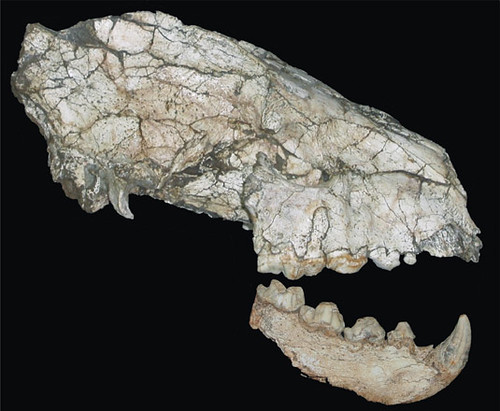A fossilized brown hyena, Hyaena brunnea,
which lived in Europe 1.8 million years ago. [Larger view].
An amazing fossil find in the Andalusian savannah in southeast Spain has revealed that a large variety of animal species lived together in that region during the boundary between the Pliocene and Pleistocene epochs, 1.8 million years ago. This discovery has so far yielded a remarkable somorgasbord of fossilized remains from at least 24 large mammal species, eight small mammal species, two reptile species and one bird species.
The fossilized remains, found at Fonelas, Spain, were from carcasses scavenged by giant hyenas, Pachycrocuta brevirostris, according to Alfonso Arribas, co-director of the dig.
"This kind of fossils can be usually found in places such as on the edge of lakes. However, in this case it seems like if hyenas had moved animal rets which died in the flooded sands to this abandoned channel", said César Viseras Alarcón, Professor of the Department of Palaeontology and Stratigraphy of the University of Granada, Spain.
In addition to giant hyenas, Arribas and Guiomar Garrido, from Spain's Geological and Mining Institute, also identified fossils from north European animals such as sabertoothed cats, river boars and mammoths; Asian animals, such as Asian animals such as Canis etruscus, the ancestor of the modern wolf; and those of African animals; a giraffe that resembles a modern okapi, gazelles and zebras. Additionally, the scientists also identified the oldest goat ever found and the earliest badger discovered in Europe.
"These mammals would have inhabited different ecotomes, but they existed in the same time and place," said Garrido.
Because Arribas and his colleagues excavated stone tools made by primitive humans at a nearby site, it is possible that early humans were contemporaries of these animals in this region, possibly attracted by the rich diversity of mammals in the area.
The discoveries was published in the journal, Palaeogeography, Palaeoclimatology, Palaeoecology, and were publically presented at the Climate and Humans conference in Murcia, Spain.
Sources
"A large-mammal site in a meandering fluvial context (Fonelas P-1, Late Pliocene, Guadix Basin, Spain) Sedimentological keys for its paleoenvironmental reconstruction" by César Viseras, Jesús M. Soria, Juan J. Durán, Sila Pla, Guiomar Garrido, Fernando GarcÃa-GarcÃa, Alfonso Arribas. Palaeogeography, Palaeoclimatology, Palaeoecology 242 (2006) 139-168. [free PDF]
BBCNews (quote, image)
University of Granada (quote)
- Log in to post comments

